- Clone
- 1B4 (See other available formats)
- Regulatory Status
- RUO
- Other Names
- Thymic stromal lymphopoietin protein receptor, cytokine receptor-like 2, CRL2, CRLF2, IL-XR, TSLP-R
- Isotype
- Mouse IgG1, κ
- Ave. Rating
- Submit a Review
- Product Citations
- publications
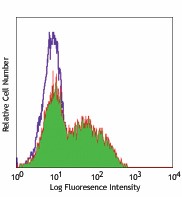
-

Human monocyte-derived dendritic cells stained with purified 1B4, followed by biotinylated anti-mouse IgG and Sav-PE
| Cat # | Size | Price | Quantity Check Availability | Save | ||
|---|---|---|---|---|---|---|
| 322802 | 100 µg | 175€ | ||||
TSLP-R, also known as the thymic stromal lymphopoietin protein receptor, cytokine receptor-like 2, CRL2, and IL-XR, is a type I membrane receptor that forms a functional heterodimeric complex with IL-7R to bind with TSLP. The TSLP-R contains a WSXWS motif required for proper protein folding and a box1 motif important for association with the JAKs. TSLP-R has a predicted molecular weight approximately 40 kD, and has two isoforms reported that are produced by alternative splicing. The TSLP-R is expressed preferentially in myeloid cells, dendritic cells, and activated monocytes. It is weakly expressed in T cells. Expression has also been reported in heart, skeletal, muscle, and kidney tissues. TSLP binding to the heterodimeric functional receptor (TSLP-R and IL-7R) activates JAK2, STAT3, and STAT5 to stimulate cell proliferation. Ligand receptor interactions have been implicated in the development of the hematopoietic system, dendritic cell maturation, and the maintenance and polarization of human Th2 memory T cells in allergy diseases.
Product DetailsProduct Details
- Verified Reactivity
- Human
- Reported Reactivity
- Baboon
- Antibody Type
- Monoclonal
- Host Species
- Mouse
- Immunogen
- Human TSLP-R:Fc protein
- Formulation
- Phosphate-buffered solution, pH 7.2, containing 0.09% sodium azide.
- Preparation
- The antibody was purified by affinity chromatography.
- Concentration
- 0.5 mg/ml
- Storage & Handling
- The antibody solution should be stored undiluted between 2°C and 8°C.
- Application
-
FC - Quality tested
WB - Reported in the literature, not verified in house - Recommended Usage
-
Each lot of this antibody is quality control tested by immunofluorescent staining with flow cytometric analysis. For flow cytometric staining, the suggested use of this reagent is ≤0.5 µg per million cells in 100 µl volume. It is recommended that the reagent be titrated for optimal performance for each application.
- Application Notes
-
For most successful immunofluorescent staining results, it may be important to maximize signal over background by using a relatively bright fluorochrome-antibody conjugate (Cat. No. 322805/322806) or by using a high sensitivity, three-layer staining technique (e.g., including a biotinylated anti-mouse IgG (Cat. No. 405303) second step, followed by SAv-PE (Cat. No. 405204)).
- RRID
-
AB_604159 (BioLegend Cat. No. 322802)
Antigen Details
- Structure
- Type I membrane receptor, forms functional heterodimeric complex with IL-7R to bind TSLP. Contains WSXWS motif required for proper protein folding and a box1 motif that is important for association with the JAKs.
- Distribution
-
Expressed preferentially in myeloid cells including dendritic cells and activated monocytes, weakly expressed in T cells. Also expressed in heart, skeletal, muscle, and kidney cells.
- Function
- TSLP binding to functional receptor activates JAK2, STAT3, and STAT5 to stimulate cell proliferation. Has been implicated in the development of the hematopoietic system, dendritic cell maturation, and the maintenance and polarization of human Th2 memory T cells.
- Interaction
- Together with IL-7R binds TSLP
- Cell Type
- Dendritic cells, Monocytes, T cells, Tregs
- Biology Area
- Immunology
- Molecular Family
- Cytokine/Chemokine Receptors
- Antigen References
-
1. Reche PA, et al. 2001. J. Immunol. 167:336.
2. Tonozuka Y, et al. 2001. Cytogenet. Cell. Genet. 93:23.
3. Zhang W, et al. 2001. Biochem. Biophys. Res. Commun. 281:878.
4. Wang YH, et al. 2006. Immunity 24:827. - Gene ID
- 64109 View all products for this Gene ID
- UniProt
- View information about TSLPR on UniProt.org
Related Pages & Pathways
Pages
Related FAQs
Other Formats
View All TSLPR Reagents Request Custom Conjugation| Description | Clone | Applications |
|---|---|---|
| Purified anti-human TSLPR (TSLP-R) | 1B4 | FC,WB |
| Biotin anti-human TSLPR (TSLP-R) | 1B4 | FC |
| PE anti-human TSLPR (TSLP-R) | 1B4 | FC |
| APC anti-human TSLPR (TSLP-R) | 1B4 | FC |
| PerCP/Cyanine5.5 anti-human TSLPR (TSLP-R) | 1B4 | FC |
| PE/Cyanine7 anti-human TSLPR (TSLP-R) | 1B4 | FC |
| APC/Fire™ 750 anti-human TSLPR (TSLP-R) | 1B4 | FC |
Customers Also Purchased
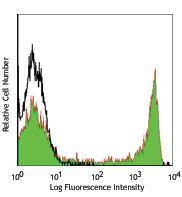

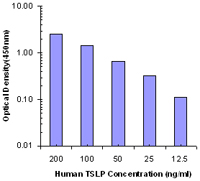
Compare Data Across All Formats
This data display is provided for general comparisons between formats.
Your actual data may vary due to variations in samples, target cells, instruments and their settings, staining conditions, and other factors.
If you need assistance with selecting the best format contact our expert technical support team.
-
Purified anti-human TSLPR (TSLP-R)
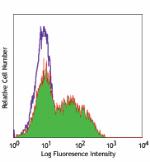
Human monocyte-derived dendritic cells stained with purified... -
Biotin anti-human TSLPR (TSLP-R)
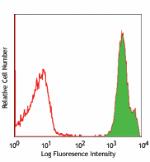
Human TSLPR transfected cells stained with biotinylated 1B4,... -
PE anti-human TSLPR (TSLP-R)
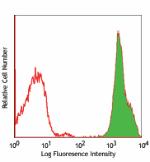
Human TSLPR transfected cells stained with 1B4 PE -
APC anti-human TSLPR (TSLP-R)
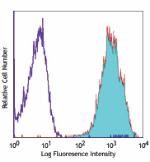
Human TSLPR transfected cells stained with 1B4 APC -
PerCP/Cyanine5.5 anti-human TSLPR (TSLP-R)
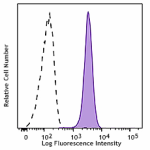
TSLPR transfected Ba/F3 cells were stained with TSLPR (Clone... -
PE/Cyanine7 anti-human TSLPR (TSLP-R)

TSLPR transfected Ba/F3 cells were stained with TSLPR (clone... -
APC/Fire™ 750 anti-human TSLPR (TSLP-R)

TSLPR transfected Ba/F3 cells were stained with TSLPR (TSLP-...
 Login / Register
Login / Register 




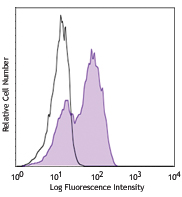



Follow Us